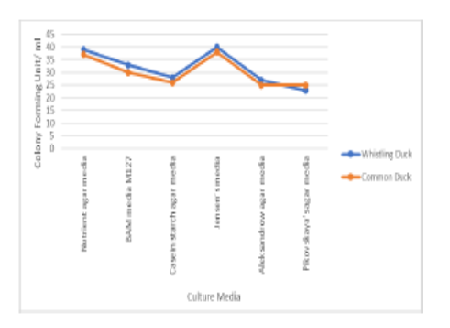


Indian Journal of Science and Technology
DOI: 10.17485/IJST/v15i36.1504
Year: 2022, Volume: 15, Issue: 36, Pages: 1764-1768
Original Article
Kangkana Medhi1, Naaz Parbin Islam1*, Jyotismita Das2
1Research Scholar, Department of zoology, Cotton University Guwahati, 781001, India
2Assistant Professor, Department of zoology, Nowgong College (Autonomous), Nagaon,782001, India
*Corresponding Author
Email: [email protected]
Received Date:18 July 2022, Accepted Date:25 August 2022, Published Date:19 September 2022
Objective: To evaluate the physico-chemical composition and the presence of potentially useful bacterial to be used as biofertilizer in the excreta of Dendrocygna javanica and Anas platyrhynchos domesticus. Methodology: The microbial culture and physico-chemical analysis was done at the department of botany, Gauhati university. Six different media were taken for microbial growth. After 24 hours of observation microbial colonies were counted and recorded. For physico-chemical analysis four parameters were taken viz., organic carbon, ash content, moisture content and pH, as those four components are essential for soil and plant growth. Findings: The excreta of Dendrocygna javanica show abundant growth of nitrogen fixing bacteria, less fastidious bacteria, yeast, moulds, Acetenomycetes and phosphate solubilizing bacteria. Physico chemical analysis have also shown favourable result against Dendrocygna javanica, indicating the biofertilizer nature of its excreta. Novelty: There is limited literature available concerning the microbial profile and physico chemical analysis of faeces of Dendrocygna javanica and Anas platyrhynchos domesticus. Infect, the present study provided the guidance for culturing and conserving these two duck species since these have a good possibility as bio fertilizers.
Keywords: Dendrocygna javanica; Anas platyrhynchos domesticus; microbial culture; physicochemical; excreta; biofertilizer
© 2022 Medhi et al. This is an open-access article distributed under the terms of the Creative Commons Attribution License, which permits unrestricted use, distribution, and reproduction in any medium, provided the original author and source are credited.
Published By Indian Society for Education and Environment (iSee)
Subscribe now for latest articles and news.